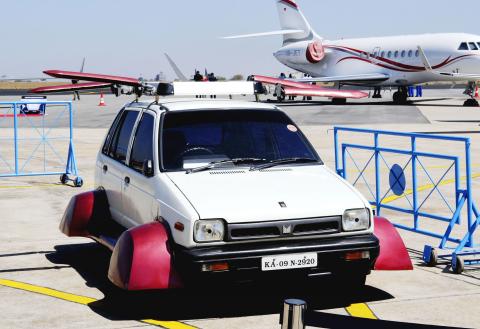It would be the ultimate answer to the daily horror of gridlock on the traffic-choked, exhaust-filled roads of Indian cities.
Unassumingly parked next to some of the world’s most lethal warplanes, a converted 800cc Maruti hatchback has stolen some of the thunder from the supersonic exhibits at the Aero India 2011 air show in the southern city of Bangalore.
The attraction? Rotating blades fitted on the four corners of the roof and a vacuum section around the tires which — its inventor insists — gives the car a vertical lift-off capability, allowing it to soar over any traffic jam.

Photo: AFP
Built in the 1980s by Japan’s Suzuki and only phased out last year, the Maruti 800 was India’s first small car, revolutionizing transport for millions of people for whom car ownership had previously been a distant dream.
Now A.K. Vishwanath is hoping his “flying Maruti” will have an equally dramatic impact on the way people look at car travel — although it has never actually flown and he is extremely tight-lipped about its exact inner workings.
“After studying 2.5 million shapes and objects linked to automobiles and working through complex theories, I built this technique which will give my car vertical lift capabilities,” the soft-spoken inventor said.
Vishwanath, 52, has devoted the past 16 years to developing his prototype, obtaining 40 patents along the way, and says he drew inspiration from many sources, including the aerial prowess of bumble bees.
An electrical generator kickstarts the device, after which its original engine pumps out “energy flows” which, he says, will provide the lift-off and cruising capability.
“My invention is backed by complex mathematics and I have already tried a scaled-down version in a wind tunnel which I built myself,” he said.
The car was developed by Vishwanath’s own company, B’Lorean — named after his hometown Bangalore and the gull-winged DeLorean sports car of the 1980s, famously used as a time-traveling machine in the Hollywood blockbuster Back To The Future.
Vishwanath says he has been approached by several firms willing to fund his work.
“Business talk can begin, but only once the necessary paperwork is out of the way,” he said.
Other specialists are also working on the project.
“I believe in its principles and I joined him to learn more about the technologies involved,” engineer B.N. Raghukumar said.
Flying cars are hardly a new concept and early prototypes of one sort or another were tested as far back as the 1930s.
Serious modern versions include the Terrafugia Transition, a “roadable aircraft” with a flying range of about 400km that has been developed by Terrafugia — a private company founded by MIT graduates in the US.
However, the fact that the flying Maruti has yet to become airborne has left many skeptical about its inventor’s claims.

The US dollar was trading at NT$29.7 at 10am today on the Taipei Foreign Exchange, as the New Taiwan dollar gained NT$1.364 from the previous close last week. The NT dollar continued to rise today, after surging 3.07 percent on Friday. After opening at NT$30.91, the NT dollar gained more than NT$1 in just 15 minutes, briefly passing the NT$30 mark. Before the US Department of the Treasury's semi-annual currency report came out, expectations that the NT dollar would keep rising were already building. The NT dollar on Friday closed at NT$31.064, up by NT$0.953 — a 3.07 percent single-day gain. Today,

‘SHORT TERM’: The local currency would likely remain strong in the near term, driven by anticipated US trade pressure, capital inflows and expectations of a US Fed rate cut The US dollar is expected to fall below NT$30 in the near term, as traders anticipate increased pressure from Washington for Taiwan to allow the New Taiwan dollar to appreciate, Cathay United Bank (國泰世華銀行) chief economist Lin Chi-chao (林啟超) said. Following a sharp drop in the greenback against the NT dollar on Friday, Lin told the Central News Agency that the local currency is likely to remain strong in the short term, driven in part by market psychology surrounding anticipated US policy pressure. On Friday, the US dollar fell NT$0.953, or 3.07 percent, closing at NT$31.064 — its lowest level since Jan.

The Financial Supervisory Commission (FSC) yesterday met with some of the nation’s largest insurance companies as a skyrocketing New Taiwan dollar piles pressure on their hundreds of billions of dollars in US bond investments. The commission has asked some life insurance firms, among the biggest Asian holders of US debt, to discuss how the rapidly strengthening NT dollar has impacted their operations, people familiar with the matter said. The meeting took place as the NT dollar jumped as much as 5 percent yesterday, its biggest intraday gain in more than three decades. The local currency surged as exporters rushed to

PRESSURE EXPECTED: The appreciation of the NT dollar reflected expectations that Washington would press Taiwan to boost its currency against the US dollar, dealers said Taiwan’s export-oriented semiconductor and auto part manufacturers are expecting their margins to be affected by large foreign exchange losses as the New Taiwan dollar continued to appreciate sharply against the US dollar yesterday. Among major semiconductor manufacturers, ASE Technology Holding Co (日月光), the world’s largest integrated circuit (IC) packaging and testing services provider, said that whenever the NT dollar rises NT$1 against the greenback, its gross margin is cut by about 1.5 percent. The NT dollar traded as strong as NT$29.59 per US dollar before trimming gains to close NT$0.919, or 2.96 percent, higher at NT$30.145 yesterday in Taipei trading